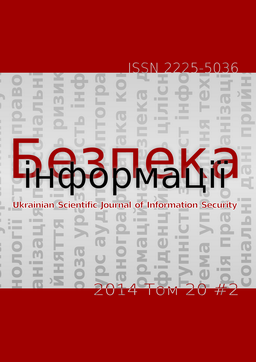Photon number splitting attack on the quantum key distribution protocol with six states
DOI:
https://doi.org/10.18372/2225-5036.20.7300Keywords:
quantum cryptography, quantum key distribution protocols, BB84 protocol, protocol with six states, photon number splitting attackAbstract
In the paper on the basis of methods of the quantum information theory the most powerful photon number splitting attack (the attack with replacement of the quantum channel with losses on ideal channel) on the protocol of quantum key distribution with six states is analyzed. It is shown that security of the protocol with six states to photon number splitting attack is higher for some percent, than security of the BB84 protocol, at any values of mean photon number in an impulse and transmission efficiency of the channel. It is also shown that, as well as for the BB84 protocol, security decreases both at increase in mean photon number, and at decrease in transmission efficiency.References
Бернет С. Криптография. Официальное руководство RSA Security / С. Бернет, С. Пэйн. – М.: ООО «Бином-Пресс», 2007. – 384 с.
Gisin, N. Quantum cryptography / N. Gisin, G. Ribordy, W. Tittel, H. Zbinden // Reviews of Modern Physics. – 2002. – V. 74, №1. – P. 145-195.
Lutkenhaus, N. Estimates for practical quantum cryptography / N. Lutkenhaus // Physical Review A. – 1999. – V. 59, №5. – P. 3301-3319.
Lutkenhaus, N. Quantum key distribution with realistic states: photon-number statistics in the photon-number splitting attack / N. Lutkenhaus, M. Jahma // New Journal of Physics. – 2002. – V. 4. – P. 44.1-44.9.
Niederberger, A. Photon-number-splitting versus cloning attacks in practical implementations of the Bennett-Brassard 1984 protocol for quantum cryptography / A. Niederberger, V. Scarani, N. Gisin // Physical Review A. – 2005. – V. 71, №4. – 042316.
Hwang, W. Y. Quantum key distribution with high loss: Toward global secure communication / W.-Y. Hwang Phys. Rev. Lett. — 2003. — Vol. 91. — 057901.
Liu, Y. Decoy-state quantum key distribution with polarized photons over 200 km / Y. Liu, T.-Y. Chen, J. Wang [та ін.] // Optical Express. – 2010. – V. 18. – P. 8587-8594.
Williamson, M. Eavesdropping on practical quantum cryptography / M. Williamson, V. Vedral // Journal of Modern Optics. – 2003. – V. 50, issue 13. – P. 1989–2011.
Bruss, D. Optimal Eavesdropping in Quantum Cryptography with Six States / D. Bruss // Physical Review Letters. – 1998. – V. 81, issue 14. – P. 3018-3021.
Василиу, Е.В. Сравнительный анализ эффективности и стойкости к некогерентным атакам квантовых протоколов распределения ключей с передачей многомерных квантовых систем / Е.В. Василиу, Р.С. Мамедов // Наукові праці ОНАЗ ім. О.С. Попова. – 2008, № 2. – С. 20-27.
Fuchs, C. Optimal Eavesdropping in Quantum Cryptography. I. Information Bound and Optimal Strategy / Fuchs C., Gisin N., Griffits R. B. [et al.] // Physical Review A. – 1997. – V. 56, issue 2. – P. 1163-1172.
Csiszar I. Broadcast channels with confidential messages / I. Csiszar, J. Korner // IEEE Trans. on Inform. Theory. –1978. – V. IT-24, № 3. – P. 339-348.

